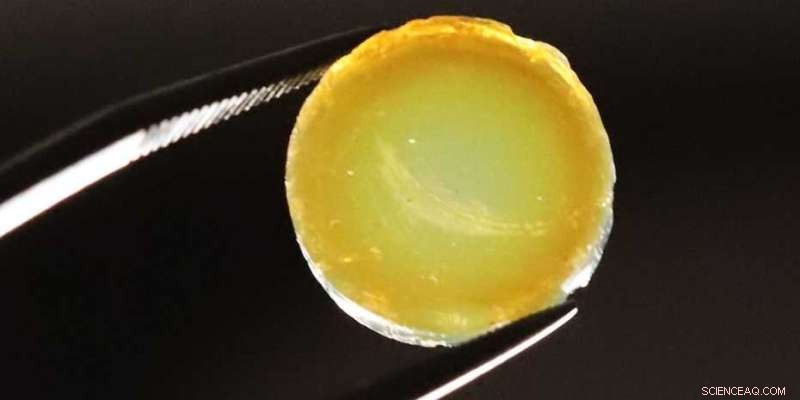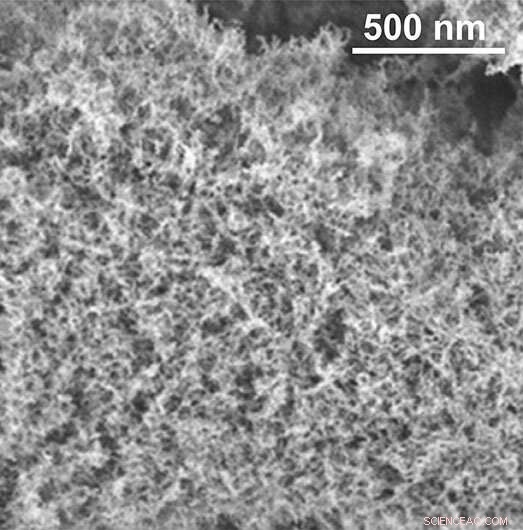
En tablettformad aerogel som består av palladium och kvävedopade TiO2 nanopartiklar. Kredit:Markus Niederberger / ETH Zürich
Aerogeler är extraordinära material som har satt Guinness världsrekord mer än ett dussin gånger, bland annat som världens lättaste fasta ämnen.
Professor Markus Niederberger från Laboratory for Multifunctional Materials vid ETH Zürich har arbetat med dessa specialmaterial under en tid. Hans labb är specialiserat på aerogeler som består av kristallina halvledarnanopartiklar. "Vi är den enda gruppen i världen som kan producera den här typen av aerogel med så hög kvalitet", säger han.
En användning för aerogeler baserade på nanopartiklar är som fotokatalysatorer. Dessa används närhelst en kemisk reaktion behöver aktiveras eller accelereras med hjälp av solljus – ett exempel är produktionen av väte.
Det valda materialet för fotokatalysatorer är titandioxid (TiO2 ), en halvledare. Men TiO2 har en stor nackdel:den kan bara absorbera UV-delen av solljus - bara cirka 5 procent av spektrumet. Om fotokatalys ska vara effektiv och industriellt användbar måste katalysatorn kunna utnyttja ett bredare våglängdsområde.
Bredda spektrumet med kvävedopning
Det är därför Niederbergers doktorand Junggou Kwon har letat efter ett nytt sätt att optimera en aerogel gjord av TiO2 nanopartiklar. Och hon hade en lysande idé:om TiO2 nanopartikel aerogel är "dopad" (för att använda den tekniska termen) med kväve, så att enskilda syreatomer i materialet ersätts av kväveatomer, aerogelen kan sedan absorbera ytterligare synliga delar av spektrumet. Dopningsprocessen lämnar aerogelens porösa struktur intakt. Studien om denna metod publicerades nyligen i tidskriften Applied Materials &Interfaces .
Kwon producerade först aerogelen med TiO2 nanopartiklar och små mängder av ädelmetallen palladium, som spelar en nyckelroll i den fotokatalytiska produktionen av väte. Hon placerade sedan aerogelen i en reaktor och infunderade den med ammoniakgas. Detta fick enskilda kväveatomer att bädda in sig i kristallstrukturen av TiO2 nanopartiklar.

Aerogelens svampliknande inre struktur. Kredit:Laboratory for Multifunctional Materials / ETH Zürich
Modifierad aerogel gör reaktionen mer effektiv
To test whether an aerogel modified in this way actually increases the efficiency of a desired chemical reaction—in this case, the production of hydrogen from methanol and water—Kwon developed a special reactor into which she directly placed the aerogel monolith. She then introduced a vapor of water and methanol to the aerogel in the reactor before irradiating it with two LED lights. The gaseous mixture diffuses through the aerogel's pores, where it is converted into the desired hydrogen on the surface of the TiO2 and palladium nanoparticles.
Kwon stopped the experiment after five days, but up to that point, the reaction was stable and proceeded continuously in the test system. "The process would probably have been stable for longer," Niederberger says. "Especially with regard to industrial applications, it's important for it to be stable for as long as possible." The researchers were satisfied with the reaction's results as well. Adding the noble metal palladium significantly increased the conversion efficiency:using aerogels with palladium produced up to 70 times more hydrogen than using those without.
Increasing the gas flow
This experiment served the researchers primarily as a feasibility study. As a new class of photocatalysts, aerogels offer an exceptional three-dimensional structure and offer potential for many other interesting gas-phase reactions in addition to hydrogen production. Compared to the electrolysis commonly used today, photocatalysts have the advantage that they could be used to produce hydrogen using only light rather than electricity.
Whether the aerogel developed by Niederberger's group will ever be used on a large scale is still uncertain. For example, there is still a question of how to accelerate the gas flow through the aerogel; at the moment, the extremely small pores hinder the gas flow too much. "To operate such a system on an industrial scale, we first have to increase the gas flow and also improve the irradiation of the aerogels," Niederberger says. He and his group are already working on these issues.
Aerogels are exceptional materials. They are extremely light and porous, and boast a huge surface area:one gram of the material can have a surface area of up to 1,200 square meters. Due to their transparency, aerogels have the appearance of "frozen smoke." They are excellent thermal insulators and so are used in aerospace applications and, increasingly, in the thermal insulation of buildings as well. However, their manufacture still requires a huge amount of energy, so the materials are expensive. The first aerogel was produced from silica by the chemist Samuel Kistler in 1931. + Utforska vidare